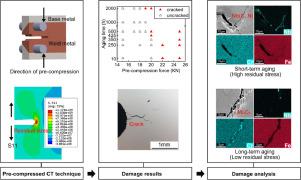Journal of Materials Science & Technology ( IF 11.2 ) Pub Date : 2021-07-29 , DOI: 10.1016/j.jmst.2021.06.010 Xiaopeng Xiao 1, 2 , Dianzhong Li 1 , Yiyi Li 1, 3 , Shanping Lu 1

|
The pre-compressed CT technique was used to quantitatively investigate the formation of stress relaxation cracks under different tensile residual stresses and aging time in Super304H austenitic stainless steel weld metal. The statistical results revealed that intergranular cracks could occur within 2000 h under 650 °C when the residual stress was applied with greater than 18 KN pre-compression force. Detailed grain interior and boundary analyses showed that the growth of intragranular Cu-rich particles could induce a strong grain interior, and the intergranular Nb(C, N) carbides were one of the causes to crack under short-term aging time. For long-term aging time conditions, the intergranular M23C6 carbides were more susceptible to crack than intergranular Nb(C, N) carbides. Finally, the mechanism responsible for stress relaxation cracking formation was carefully illustrated for the weld metals after short-term aging and long-term aging, respectively.
中文翻译:

Super304H奥氏体不锈钢焊缝金属组织演变及应力松弛开裂机理
采用预压缩CT技术定量研究了Super304H奥氏体不锈钢焊缝金属在不同拉伸残余应力和时效时间下应力松弛裂纹的形成。统计结果表明,当残余应力施加大于 18 KN 的预压缩力时,在 650 °C 下 2000 h 内可能会出现晶间裂纹。详细的晶粒内部和边界分析表明,晶内富铜颗粒的生长会导致强烈的晶粒内部,晶间 Nb(C, N) 碳化物是短期时效下开裂的原因之一。对于长期老化时间条件,晶间 M 23 C 6碳化物比晶间 Nb(C, N) 碳化物更容易开裂。最后,分别针对短期时效和长期时效后的焊缝金属详细说明了应力松弛裂纹形成的机制。















































 京公网安备 11010802027423号
京公网安备 11010802027423号